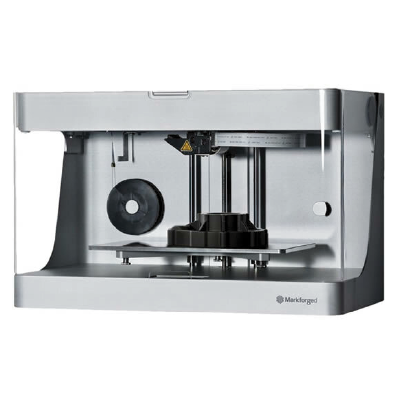Veröffentlicht vor 4 Jahren
Markforged Mark Two
(0)
Nicht verfügbar für Online-Buchung
Dieser Artikel hat noch keinen Preis.
Bilder
Beschreibung
Markforged Mark Two – Book & Rent On-Site at Our Lab
The Markforged Mark Two is a high-performance desktop 3D printer built for printing strong, functional parts reinforced with continuous fibers like carbon fiber and Kevlar®. Whether you're developing prototypes, jigs, fixtures, or end-use parts, this composite 3D printer delivers industrial-grade results—now available for on-site rental through our lab.
Reserve the Markforged Mark Two to prototype, experiment, and iterate with cutting-edge materials—all without the cost of ownership.
What Is the Markforged Mark Two?
The Markforged Mark Two is a professional-grade composite 3D printer known for its Continuous Fiber Reinforcement (CFR) technology. It uses FFF (Fused Filament Fabrication) for standard thermoplastics, while also embedding strong fibers like carbon fiber, fiberglass, or Kevlar within the part’s layers for significantly increased strength and stiffness.
This dual-extrusion system makes it ideal for engineering applications that require high strength-to-weight ratios—providing performance that rivals machined aluminum in many cases.
Applications and Use Cases
The Mark Two supports a range of high-impact applications across industries:
• Functional Prototypes – Create realistic prototypes with mechanical properties suitable for testing and iteration.
• End-Use Parts – Print small-batch or custom components strong enough for real-world use.
• Tooling and Fixtures – Produce durable jigs, clamps, and fixtures for manufacturing and assembly processes.
• Robotics & Automation – Lightweight structural components with fiber reinforcement make it ideal for drones and robotic arms.
• Education & Research – Use advanced materials to support engineering, materials science, and manufacturing innovation.
• Aerospace and Automotive Projects – Replace machined aluminum with lightweight composite parts.
Considerations and Advantages
Here’s why the Markforged Mark Two stands out—and what to know before you book:
• Carbon Fiber Reinforcement – Delivers unmatched strength and stiffness in printed parts.
• Professional Software Integration – Includes access to Eiger™, a cloud-based platform for print preparation, part simulation, and material tracking.
• Dimensional Accuracy – Excellent part tolerance, repeatability, and consistency.
• Material Compatibility – Compatible with Onyx (nylon + chopped carbon fiber), continuous fibers (carbon fiber, Kevlar, fiberglass), and more.
• No Ownership Overhead – By renting, you avoid maintenance, calibration, and material sourcing concerns—our lab handles it all.
Maintaining and Optimizing Performance
While our team ensures the Mark Two is ready to go, you can optimize your print session by keeping the following in mind:
• Choose the Right Fiber Strategy – Not all parts need full reinforcement; optimize where strength is most needed.
• Use Eiger Efficiently – Familiarize yourself with Eiger™ for fiber routing, slicing, and build-time estimation. Our staff can guide you if needed.
• Monitor Print Settings – Default profiles are reliable, but custom settings may be adjusted for advanced users.
• Material Handling – Keep Onyx dry and store fibers as directed—our lab maintains ideal conditions.
• Part Removal – Let parts cool before removal to avoid warping and improve accuracy.
Why Rent the Markforged Mark Two in Our Lab?
Choosing to rent the Mark Two at our facility provides multiple benefits:
• Immediate access to composite 3D printing technology
• Expert support during setup, slicing, and post-processing
• A collaborative maker environment with professional tools
• No need to invest in a full system for short-term projects
• Flexible time slots for one-off tasks or extended prototyping sessions
CFR stands for Continuous Fiber Reinforcement, which is an advanced 3D printing technology that enhances the strength and performance of printed parts. This process involves embedding continuous fibers such as carbon fiber, fiberglass, or Kevlar within the layers of a 3D printed object.
Key features of CFR technology include:
- Dual extrusion system: It uses two separate nozzles - one for standard thermoplastics and another for continuous fibers.
- Exceptional strength: CFR parts can be up to 10 times stronger than standard 3D printed materials like ABS or PLA.
- Aluminum replacement: In many applications, CFR parts can replace machined aluminum due to their high strength-to-weight ratio.
- Material compatibility: CFR works with materials like Onyx (a blend of nylon and chopped carbon fiber) as the base, which can then be reinforced with continuous fibers.
- Strategic reinforcement: The continuous fibers are placed only in areas of high stress or where additional stiffness is required, optimizing part performance and manufacturing time.
- CFR technology significantly expands the capabilities of 3D printing, allowing for the production of functional, durable parts suitable for various industrial applications.
Bewertungen
— Es gibt noch keine Bewertungen —

